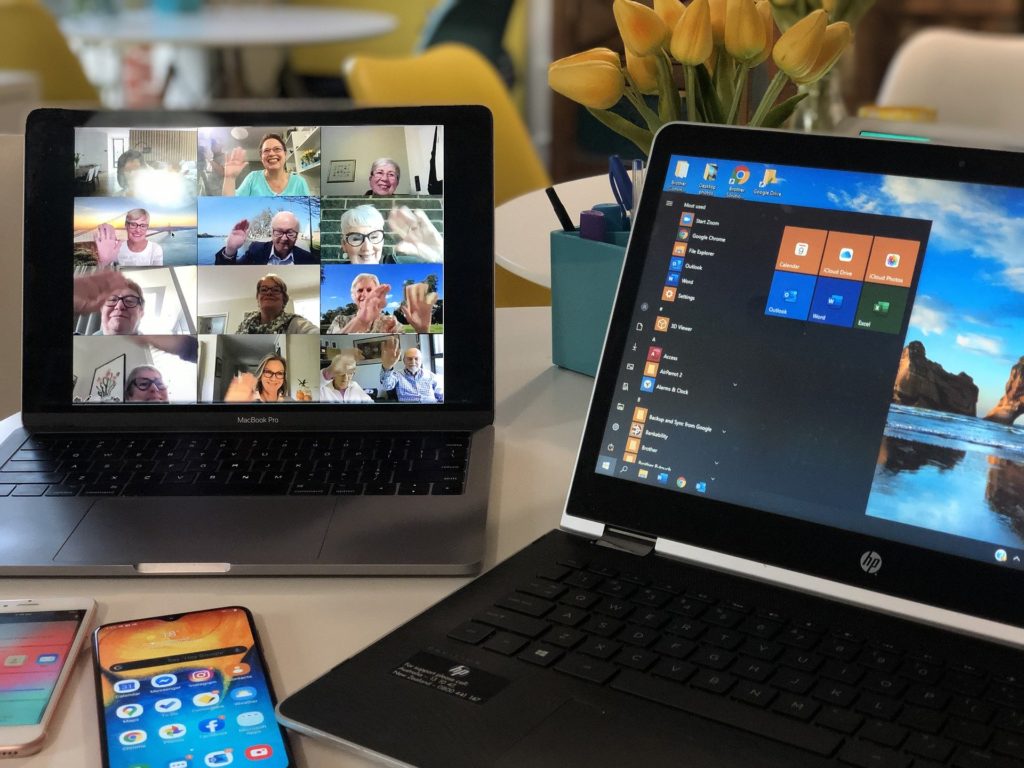A Roundup of Zoom Tips (and a few unconventional takes on them!)
Published on September 28, 2020
At the start of the pandemic, nobody was an expert at videoconferencing. Well, that’s not quite right … There have been a steady stream of Zoom Tips articles from “experts” in the field, containing everything from “get good at lighting” to “what to wear” on multiple platforms, from the New York Times to the Wall Street Journal. In this article, we reflect on some of their advice, turning some of their tips upside down to give you another perspective on planning, leading, and attending videoconferencing events.

1. Prioritize
Our first against the grain point: experts typically ask you to engage fully, to avoid multitasking, and be present for all of your Zoom meetings. But when we are Zooming 5-6 hours a day, we can’t give every meeting our best. It takes a lot of energy and time away from other tasks that we have outside of these meetings. Instead, prioritize your meetings, and plan your day to have the most energy for the most important ones! Categorizing your meetings might help in this prioritization process:
Lead: Meetings that you lead, and require both your attention and preparation. For these meetings, you’re spending time preparing introductions, an agenda, process, and materials. You need to be on for these meetings, and these call for your full attention. Don’t multitask in these meetings, keep your video on, dress professionally, and stay focused on moving through your planned topics. Keep one other window open, but only with notes and an agenda for getting through the meeting items and keeping everyone on task.
Participate: Meetings that require your attention, but not a ton of preparation, except to know the purpose and agenda, as well as your own take on those topics. During these meetings, listen actively throughout and be prepared to engage at any point, but determine where your attention is most needed in the agenda beforehand and focus on those sections. Mute your audio unless speaking, but keep your video on and your eyes directed on screen, even if you’re multitasking at some limited points throughout the meeting.
Listen: Meetings that require your attendance, but are FYI rather than FYO (for your opinion). For these meetings, balance multitasking with engagement by keeping a window open for notes, and actively listening for important issues. Demonstrate your engagement by participating in chat at various points, and asking to speak when appropriate. Decide whether it’s necessary for you to share video beforehand, and prepare accordingly.
As virtual meetings take over our days, we really have to acknowledge the limits of our attention and energy, Prioritizing our meetings allows us to engage and perform where it matters most, while maintaining our attention where we need it.
2. Make Meetings Accomodating
One Zoom tip floating around everywhere is: be on time, or early. One of the articles above suggests that locking the meeting door five minutes after the start off a Zoom call is appropriate. But this is not collegial behavior. Instead, plan to make attending the meeting convenient for attendees by engaging in some of these techniques:
- Schedule meetings for 10 minutes after the hour. If we are hopping around on Zoom calls for 5-6 hours a day, we need breaks – physical ones for eating and bathrooms, and mental ones to gather ourselves for your next meetings. Give your participants that break by acknowledging that they may be coming from another meeting, and start your meetings at 10 after the hour. Allow attendees who come early to chit chat between the top of the hour and the start of the meeting, and open up that space for collegial talk (what was once known as water cooler talk). Nobody ever complained about a meeting that was too short, so while taking 10 minutes off a 1 hour meeting may mean you will have to be more efficient, it also means your attendees will leave happier.
- Outline rules of engagement at the outset of the meeting. Tell attendees whether they can just interrupt, should raise their hands, or type their questions or feedback in the chat to participate in the discussion. Knowing the proper procedure and sticking to it allows you to control the flow of the meeting and ensure that your attendees are heard (and not heard too much).
- Create an agenda that is as short as possible, stick to it, and transition through the items explicitly, recapping key points or action items as you move to the next item. This helps attendees stay on track, focus on the key issues, and know what their responsibilities are coming out of the meetings. And it helps those late attendees catch up and stay on track.
Mostly, take those articles on “How to Zoom” with a grain of salt. Not everyone has the privilege of private work space in their home; nobody can be 100% engaged in every meeting. Give yourself and your attendees the space to be imperfect, and develop strategies that help account for that imperfection, and that create efficient meetings for all participants.
We will have more standard articles on videoconferencing techniques soon, but thought we should start by acknowledging our own limits.

